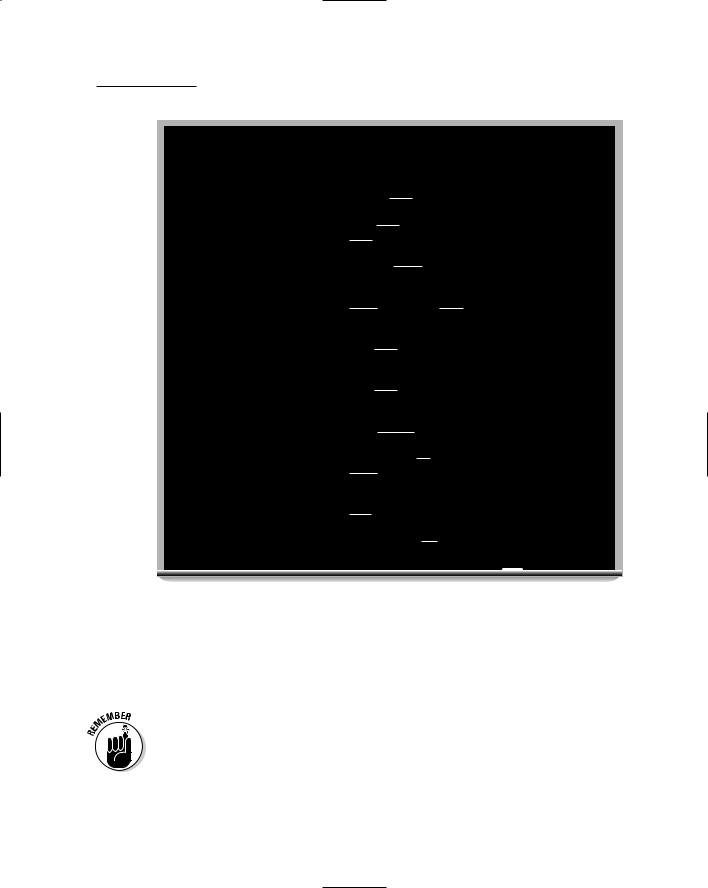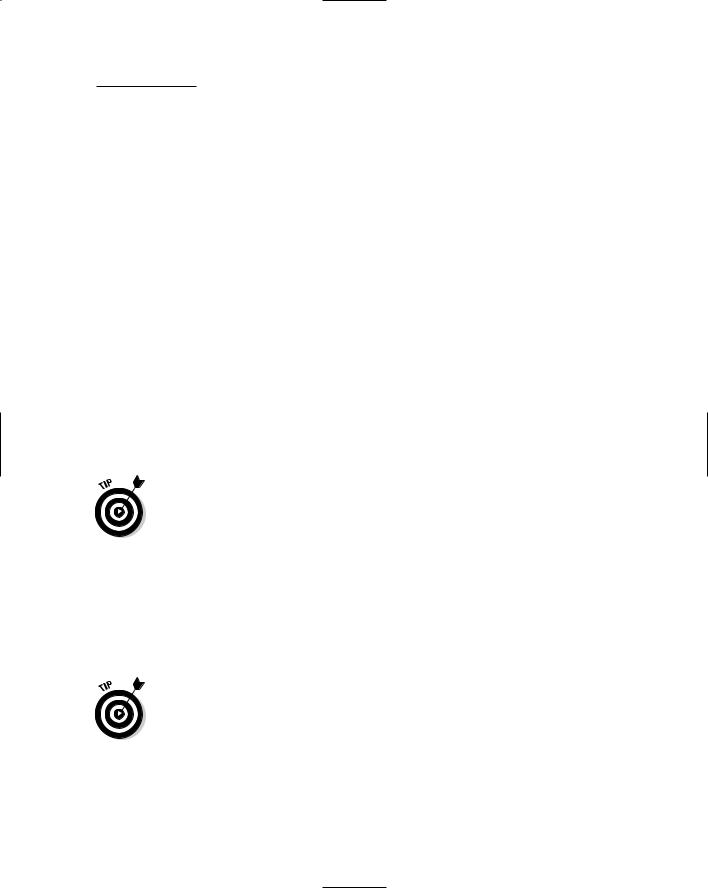
Russian For Dummies
.pdf
54 |
Part I: Getting Started |
Talkin’ the Talk
Viktor and Marina are former co-workers. They meet after a long absence.
Viktor: |
Privyet Marina, chto novogo? Kuda vy propali? |
|
pree-vyet mah-ree-nuh, shtoh noh-vuh-vuh? koo-dah |
|
vih prah-pah-lee? |
|
Hi Marina, what’s new? Where’ve you disappeared |
|
to? |
Marina: |
Privyet, Viktor! Ya nyeskol’ko myesyatsyev |
|
otdykhala, a potom nachala rabotat’ v shklolye. |
|
Pree-vyet, veek-tuhr! ya nyes-kuhl’-kuhl’ mye-see- |
|
tsehf uh-dih-khah-luh, ah pah-tohm nuh-chuh-lah |
|
rah-boh-tuht’ f shkoh-lee. |
|
Hi Viktor! I relaxed for several months, and then I |
|
started to work at a school. |
Viktor: |
Oj kak intyeryesno! Ya tozhye rabotal odnazhdy v |
|
shkolye. Kak vam eto nravitsya? |
|
Ohy kahk een-tee-ryes-nuh! ya toh-zheh rah-boh-tuhl |
|
ahd-nahzh-dih f shkoh-lee. kahk vahm eh-tuh nrah- |
|
veet-sye? |
|
Oh, how interesting! I also worked once at a school. |
|
How do you like it? |
Marina: |
Nichyego, no ya predpochitayu otdykhat’. |
|
Nee-chee-voh, noh ya preet-puh-chee-tah-yu uh-dih- |
|
khaht’. |
|
Not bad, but I prefer to relax. |
Viktor: |
Soglasyen, no k sozhalyeniyu nado rabotat’. |
|
sah-glah-seen, noh k suh-zhah-lye-nee-yu nah-duh |
|
ruh-boh-tuht’. |
|
I agree, but unfortunately one has to work. |
|
|

Chapter 2: The Nitty Gritty: Basic Russian Grammar and Numbers |
55 |
Words to Know
Chto novogo? |
shtoh noh-vuh-vuh |
What’s new? |
Kuda vy propali? |
koo-dah vih prah- |
Where’ve you |
|
pah-lee |
disappeared to? |
otdykhala |
uh-dih-khah-luh |
relaxed (feminine, |
|
|
singular) |
nyeskol’ko |
nyes-kuhl’-kuh mye- |
for several |
myesyetsev |
see-tsehf |
months |
rabotat’ |
ruh-boh-tuht’ |
to work |
|
|
(imperfective) |
rabotal |
ruh-boh-tuhl |
worked (masculine, |
|
|
singular) |
odnazhdy |
ahd-nahzh-dih |
once/at one time |
Kak vam nravitsya? |
kahk vahm eh-tuh |
How do you like it? |
|
nrah-veet-sye |
|
Ya predpochitayu . . . |
yah preet-puh-chee- I prefer to . . . |
|
|
tah-yu |
(+ infinitive) |
k sozhalyeniyu |
k suh-zhah-lye- |
unfortunately |
|
nee-yu |
|
Planning for the future tense
To describe an action that will take place in the future, Russian uses the future tense. While English has many different ways to talk about the future, Russian has only two: the future imperfective and the future perfective.
You use the future imperfective when you want to emphasize the fact that something will happen or be happening in the future, but you don’t necessarily want to emphasize the result or completion of an action. You use the future perfective to emphasize result or completion of an action.

56 |
Part I: Getting Started |
To form the future imperfective, you use the future tense form of the verb byt’ (biht’; to be) plus the imperfective infinitive. This combination translates into “will/will be.” Table 2-13 shows the conjugation of the verb byt’ in the future tense. (Find out more about this interesting verb in the next section.)
Table 2-13 |
Conjugation of Byt’ in the Future Tense |
|
Pronoun |
|
Correct Form of Byt’ |
ya (I) |
|
budu (boo-doo) |
|
|
|
ty (you; informal singular) |
budyesh’ (boo-deesh’) |
|
|
|
|
on/ona/ono (he/she/it) |
|
budyet (boo-deet) |
|
|
|
my (we) |
|
budyem (boo-deem) |
|
|
|
vy (you; formal singular and plural) |
budyetye (boo-dee-tee) |
|
|
|
|
oni (they) |
|
budut (boo-doot) |
|
|
|
If you want to say “I will read (but not necessarily finish reading) the article,” you use the ya (I) form of the verb byt’ plus the imperfective infinitive chitat’ (chee-taht’; to read): Ya budu chitat’ stat’yu (ya boo-doo chee-taht’ staht’-yu).
To form the future perfective, you simply conjugate the perfective form of the verb, as in Ya prochitayu stat’yu syegodnya (ya pruh-chee-tah-yu staht’-yu see-vohd-nye; I’ll read/finish reading the article today). In other words, you use the ending -yu for ya (I) as you do in the present tense. See the previous section for more about perfective verbs.
Using the unusual verb byt’ (to be)
Russian has no present tense of the verb to be. To say “I’m happy,” you just say Ya schastliv (ya sh’as-leef; Literally: I happy). To say “That’s John,” you just say Eto Dzhon (eh-tuh dzhohn; Literally: That John). The being verbs am, are, and is are implicitly understood in the present tense.
To express the verb to be in the past tense, you need to use the proper past tense form of the verb byt’:
byl (bihl; was) if the subject is a masculine singular noun
byla (bih-lah; was) if the subject is a feminine singular noun
bylo (bih-luh; was) if the subject is a neuter singular noun
byli (bih-lee; was) if the subject is a plural noun or if the subject is vy (vih; you; formal singular)

Chapter 2: The Nitty Gritty: Basic Russian Grammar and Numbers |
57 |
To express the verb to be in the future tense, you have to use the correct form of the verb byt’ in the future tense. (For conjugation, refer to Table 2-13.) To say “I will be happy,” you say Ya budu schastliv (ya boo-doo sh’as-leef), and for “I will be there,” you say Ya budu tam (ya boo-doo tahm).
Providing Extra Details with Adverbs
Adverbs are words like very, quickly, and beautifully. They add information to a verb, an adjective, or even another adverb. Russian adverbs are one of the most uncomplicated parts of speech. Unlike nouns, verbs, and adjectives, adverbs never change their form. In the following sections, you discover the main categories of Russian adverbs: adverbs of manner and adverbs of time.
Describing how
You use some adverbs to describe how an action is performed. These adverbs are called adverbs of manner, and they’re easy to spot because they usually end in -o. In fact, you can consider the ending -o as a kind of equivalent of the ending -ly in English adverbs.
Some adverbs of manner you probably hear and use a lot are khorosho (khuh-rah-shoh; well), plokho (ploh-khuh; poorly), pravil’no (prah-veel’-nuh; correctly), nyepravil’no (nee- prah-veel’-nuh; incorrectly), bystro (bihs-truh; quickly), myedlyenno (myed-lee-nuh; slowly), lyegko (leekh-koh; easily), and prosto (proh-stuh; simply).
Describing when and how often
To describe when and how often the action took place, Russian uses time adverbs. Like adverbs of manner, time adverbs are recognizable because they usually end in -o (and sometimes in -a).
Some of the most common time adverbs are chasto (chahs-tuh; often), ryedko (ryed-kuh; rarely), inogda (ee-nahg-dah; sometimes), nikogda (nee- kahg-dah; never), vsyegda (fseeg-dah; always), skoro (skoh-ruh; soon), obychno (ah-bihch-nuh; usually), rano (rah-nuh; early), pozdno (pohz-nuh; late), and dolgo (dohl-guh; for a long time).

58 |
Part I: Getting Started |
Constructing Sentences Like a Pro
The whole point of learning grammar is to actually create Russian-sounding sentences. In the following sections, you discover how to do just that. You have a lot of freedom of word order when creating Russian sentences. You get tips on selecting the noun or pronoun, adjectives, and verb, and you see how to connect different parts of a sentence with conjunctions. You also find out how to form questions in Russian.
Enjoying the freedom of word order
One of the biggest differences between English and Russian is that English tends to have a fixed order of words, whereas Russian enjoys a free order of words.
In English, word order can often determine the meaning of a sentence. For example, in English you say, “The doctor operated on the patient,” but you never say “The patient operated on the doctor.” It just doesn’t make sense.
In Russian, however, it’s perfectly okay to put patsiyenta at the beginning of the sentence and doktor at the end, as in Patsiyenta opyeriroval doktor
(puh-tsee-yent-uh uh-pee-ree-ruh-vuhl dohk-tuhr). It still means “The doctor operated on the patient” even though it looks like “The patient operated on the doctor.” If you wanted to, you could even put opyeriroval first, patsiyenta second, and doktor at the end, as in Opyeriroval patsiyenta doktor.
It still means “The doctor operated on the patient” even though it looks like “Operated on the patient the doctor.”
In Russian, you can freely shift around the order of words in a sentence, because the Russian case system tells you exactly what role each word plays in the sentence. (For additional information on cases, see “Making the Russian Cases” earlier in this chapter.)
As a rule, you give new information or information you want to emphasize at the end of a Russian sentence and the least important information at the beginning of a Russian sentence.
Selecting the noun (or pronoun) and adjective
Usually, the first step in forming a sentence is deciding on which nouns and adjectives to use. If you want to say “I’m reading an interesting article,” the first thing you need to decide is what role each of the nouns and pronouns plays in the sentence, so you can decide which case to put them into. In this sentence, “I” is the subject and “interesting article” is the direct object.

Chapter 2: The Nitty Gritty: Basic Russian Grammar and Numbers |
59 |
The subject of a sentence is always in the nominative case, and the direct object is always in the accusative case. The nominative case for the pronoun “I” is ya, and now we have to put intyeryesnaya stat’ya (een-tee-ryes-nuh-ye staht’-ya; interesting article) into the accusative case. (For details on cases, see “Making the Russian Cases” earlier in this chapter.)
Start with the feminine noun, stat’ya. Table 2-2 says that if a noun ends in -ya, then you form the accusative case by replacing -ya with -yu, so now you have stat’yu. And as for the adjective intyeryesnaya, it must agree in gender, case, and number with the noun it modifies. The dictionary form of “interesting” in Russian is intyeryesnyj. From Table 2-10 you know that this adjective takes the ending -uyu when it modifies a feminine noun in the accusative case. Presto! You now have intyeryesnuyu. (See “Decorating Your Speech with Adjectives” earlier in this chapter for more information.)
Choosing the verb
After you decide on the verb and tense you want to use in your sentence, you just need to make sure it agrees in number (and in gender if it’s in the past tense) with the subject of the sentence. (For more, see “Adding Action with Verbs” earlier in this chapter.)
In the sentence “I’m reading an interesting article,” the verb is obviously in the present tense and agrees with the singular pronoun “I.” Table 2-11 in the section “Living in the present tense” earlier in this chapter says that you form the first person singular present tense verb by replacing the infinitive ending -t’ with -yu. So the verb form you want is chitayu from the infinitive chitat’. The whole sentence is Ya chitayu intyeryesnuyu stat’yu (ya chee-tah-yu een- tee-ryes-noo-yu staht’-yu; I’m reading an interesting article). Congratulations! You’ve just created a complete Russian sentence!
Connecting with conjunctions
Sometimes you may want to connect words or phrases in a sentence with conjunctions, which are words like and, but, and however. “And” in Russian is i (ee), “but” is a (ah), and “however” is no (noh).
Forming questions
Forming questions in Russian is easy. You simply begin your sentence with a question word like kto (ktoh; who), chto (shtoh; what), gdye (gdye; where), kogda (kahg-dah; when), pochyemu (puh-chee-moo; why), or kak (kahk; how). And then you form your sentence as if you were making a statement.

60 |
Part I: Getting Started |
For example, a man you know makes an exciting statement: Ya syegodnya nye zavtrakal (ya see-vohd-nye nee zahf-truh-kuhl; I didn’t have breakfast today). Being a polite person, you need to somehow respond to this news.
You may ask why your interlocutor didn’t have breakfast. That’ll demonstrate to him that you listened carefully to what he had to say. You ask:
Pochyemu ty syegodnya nye zavtrakal? (puh-chee-moo tih see-vohd-nye nee zahf-truh-kuhl; Why didn’t you have breakfast today?)
That’s how simple it is! No auxiliary verbs, no changing the verb back to its infinitive form as you have to do in English! Asking questions is so much easier in Russian than in English, isn’t it?
In Russian, you don’t have to invert the subject and the verb when you’re forming questions.
Counting in Russian
You’re probably not going to need to know numbers beyond talking about how many siblings you have (which we explain in Chapter 4), telling time (which we talk about in Chapter 7), or counting your money (which we talk about in Chapter 14). But just in case, knowing the numbers in the following sections should help you with all other possible counting needs.
The harsh truth is that each Russian number changes its form for all six cases! But unless you plan to spend a lot of time at mathematics or accounting conferences conducted in Russian, you won’t find yourself in many practical situations in which you need to know all the different forms. So we give you all the numbers you need to know only in the nominative case.
Numbers 0–9
These are the numbers you’ll probably use most often when counting groceries, siblings, friends, and other people and things around the house:
0 nol’ (nohl’)
1 odin (ah-deen)
2 dva (dvah)
3 tri (tree)

Chapter 2: The Nitty Gritty: Basic Russian Grammar and Numbers |
61 |
4 chyetyrye (chee-tih-ree)
5 pyat’ (pyat’)
6 shyest’ (shehst’)
7 syem’ (syem’)
8 vosyem’ (voh-seem’)
9 dyevyat’ (dye-veet’)
But wait! You have to use a few rules when you use these numbers. The following sections give you the scoop.
The number 1 followed by a noun
If the noun you’re referring to is masculine, you say odin followed by the noun as in odin chyelovyek (ah-deen chee-lah-vyek; one man). If the noun is feminine you say odna as in odna dyevushka (ahd-nah dye-voosh-kuh; one girl). And if the noun is neuter you say odno as in odno okno (ahd-noh ahk- noh; one window).
The number 2 followed by a noun
If you’re talking about nouns that are masculine or neuter, you say dva, and if the noun is feminine, dva becomes dvye. After the numeral 2, you have to put the noun into the genitive case singular as in dva chyelovyeka (dvah chee- lah-vye-kuh; two men), dva okna (dvah ahk-nah; two windows), and dvye dyevushki (dvye dye-voosh-kee; two girls). For rules on forming genitive case for singular nouns, see Table 2-2 earlier in the chapter.
The numbers 3 and 4 followed by a noun
Like the numeral dva (dvah; two), tri (tree; three) and chyetyrye (chee-tih- ree; four) also require the noun used after them to be put into the genitive singular. (For rules on forming genitive case, see Table 2-2 earlier in the chapter.) Unlike odin and dva, these numbers don’t change their form depending on the gender of the noun they refer to.
The numbers 5 through 9 followed by a noun
Any noun you use after the numerals 5–9 must be put into the genitive plural case, as in the phrase pyat’ dyevushyek (pyat’ dye-voo-shuhk; five girls) and syem’ mal’chikov (syem’ mahl-chee-kuhf; seven boys). (See “Changing plurals into the genitive case” earlier in this chapter.) Unlike odin and dva, these numbers don’t change their form depending on the gender of the noun they are used with.

62 |
Part I: Getting Started |
Numbers 10–19
The following are the numbers 10 through 19:
10 dyesyat’ (dye-seet’)
11 odinnadtsat’ (ah-dee-nuht-tsuht’)
12 dvyenadtsat’ (dvee-naht-tsuht’)
13 trinadtsat’ (tree-naht-tsuht’)
14 chyetyrnadtsat’ (chee-tihr-nuht-tsuht’)
15 pyatnadtsat’ (peet-naht-tsuht’)
16 shyestnadtsat’ (sheest-naht-tsuht’)
17 syemnadtsat’ (seem-naht-tsuht’)
18 vosyemnadtsyat’ (vuh-seem-naht-tsuht’)
19 dyevyatnadtsat’ (dee-veet-naht-tsuht’)
Starting with the numeral 11, Russian numerals up to 19 follow a recognizable pattern of adding -nadtsat’ (naht-tsuht’) to the numerals 1 through 9 (see the previous section). You can, however, find a few slight deviations to this rule, so watch out:
Dvyenadtsat’ (dvee-naht-tsuht’; 12) changes the dva (dvah; two) to a dvye (dve; two)
Chyetyrnadtsat’ (chee-tihr-nuht-tsuht’; 14) loses the final e in chyetyrye (chee-tih-ree; four)
The numerals 15–19 all lose the final soft signs contained in 5–9 (For example, 15 is pyatnadtsat’ and not pyat’nadtsat’).
Nouns following all these numerals take the genitive plural.
Numbers 20–99
To say 21, 22, 31, 32, 41, 42 . . . and so on, all you need to do is add the numerals 1 through 9 to the numeral 20, 30, 40 . . . and so on. See the following list for multiples of ten:
20 dvadtsat’ (dvaht-tsuht’)
30 tridtsat’ (treet-tsuht’)
40 sorok (soh-ruhk)
50 pyatdyesyat’ (pee-dee-syat’)

Chapter 2: The Nitty Gritty: Basic Russian Grammar and Numbers |
63 |
60 shyestdyesyat’ (shees-dee-syat’)
70 syem’dyesyat’ (syem’-dee-seet’)
80 vosyemdyesyat’ (voh-seem-dee-seet’)
90 dyevyanosto (dee-yee-nohs-tuh)
Therefore, you make the numbers 21–23 like this:
21 dvadtsat’ odin (dvaht-tsuht’ ah-deen)
22 dvadtsat’ dva (dvaht-tsuht’ dva)
23 dvadtsat’ tri (dvaht-tusht’ tree)
When using nouns after these numerals, be sure to put the noun in the nominative after each number ending in 1 (as in 21 and 31); in the genitive singular case after each number ending in 2, 3, or 4 (as in 42, 53, and 64); and in the genitive plural case after all the others.
Numbers 100–999
You form each of the following numerals (except 200) by adding either a sta or a sot to the numerals 1–10:
100 sto (stoh)
200 dvyesti (dvye-stee)
300 trista (tree-stuh)
400 chyetyryesta (chee-tih-rees-tuh)
500 pyat’sot (peet’-soht)
600 shyest’sot (shees’-soht)
700 syem’sot (seem’-soht)
800 vosyem’sot (vuh-seem’-soht)
900 dyevyat’sot (dee-veet’-soht)
Sta (stah; 100) is actually the genitive singular form of sto (stoh; 100), and it makes sense that this is the form used with the “100” part of the numerals 200, 300, and 400, because 2, 3, and 4 force the noun after them into the genitive singular. It’s as if the numeral 100 (sto) is treated like a noun when it comes after the numerals 2, 3, and 4, in 200, 300, and 400. The exception to this rule is dvyesti (200), in which sto becomes sti rather than sta. And sot (soht; 100) is the genitive plural form of sto. This fact also makes sense because the numerals 5–9 all take the genitive plural after them.
